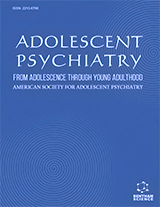Abstract
Background and Objective: Negative parent-child interaction patterns have been linked to youth depression, with a causal influence being assumed. However, the majority of empirical studies examining this issue have used self-report methods to assess parent-child relationships, which cannot capture the temporal dynamics of dyadic interactions and may be subject to reporting bias. This review considers the association between parent-child interactions and youth depression with a specific focus on observational methodology.
Method: A literature search was conducted including studies that investigated the association between observed parent-child interactions and youth depressive symptomology. Literature was obtained using database searches, citation searches and screening of recent reviews. Results and Conclusion: Maternal disengagement, reduced adolescent autonomy granting, adolescent maladaptive emotion regulation, parental suppression of adolescent positivity and incongruent parent-child communication styles were relatively consistently related to youth depression. Nonetheless, there were conflicting findings and several studies demonstrated little or no contribution of parent-child interaction factors to youth depression. Overall, the evidence suggests that causal influences are likely to be modest. The majority of studies relate to maternal versus paternal interactions. Furthermore, the factors that mediate the association between parent-child interactions and youth depression remain largely unknown. Implications for future research and clinical practice are discussed.Keywords: Adolescence, childhood, depression, observations, parent-child interactions.
Adolescent Psychiatry
Title:How Do Parent-Child Interactions Predict and Maintain Depression in Childhood and Adolescence? A Critical Review of the Literature
Volume: 6 Issue: 2
Author(s): Rosanna Chapman, Monika Parkinson and Sarah Halligan
Affiliation:
Keywords: Adolescence, childhood, depression, observations, parent-child interactions.
Abstract: Background and Objective: Negative parent-child interaction patterns have been linked to youth depression, with a causal influence being assumed. However, the majority of empirical studies examining this issue have used self-report methods to assess parent-child relationships, which cannot capture the temporal dynamics of dyadic interactions and may be subject to reporting bias. This review considers the association between parent-child interactions and youth depression with a specific focus on observational methodology.
Method: A literature search was conducted including studies that investigated the association between observed parent-child interactions and youth depressive symptomology. Literature was obtained using database searches, citation searches and screening of recent reviews. Results and Conclusion: Maternal disengagement, reduced adolescent autonomy granting, adolescent maladaptive emotion regulation, parental suppression of adolescent positivity and incongruent parent-child communication styles were relatively consistently related to youth depression. Nonetheless, there were conflicting findings and several studies demonstrated little or no contribution of parent-child interaction factors to youth depression. Overall, the evidence suggests that causal influences are likely to be modest. The majority of studies relate to maternal versus paternal interactions. Furthermore, the factors that mediate the association between parent-child interactions and youth depression remain largely unknown. Implications for future research and clinical practice are discussed.Export Options
About this article
Cite this article as:
Chapman Rosanna, Parkinson Monika and Halligan Sarah, How Do Parent-Child Interactions Predict and Maintain Depression in Childhood and Adolescence? A Critical Review of the Literature, Adolescent Psychiatry 2016; 6 (2) . https://dx.doi.org/10.2174/2210676606666160822101450
| DOI https://dx.doi.org/10.2174/2210676606666160822101450 |
Print ISSN 2210-6766 |
| Publisher Name Bentham Science Publisher |
Online ISSN 2210-6774 |
 73
73 10
10
- Author Guidelines
- Bentham Author Support Services (BASS)
- Graphical Abstracts
- Fabricating and Stating False Information
- Research Misconduct
- Post Publication Discussions and Corrections
- Publishing Ethics and Rectitude
- Increase Visibility of Your Article
- Archiving Policies
- Peer Review Workflow
- Order Your Article Before Print
- Promote Your Article
- Manuscript Transfer Facility
- Editorial Policies
- Allegations from Whistleblowers
- Announcements
Related Articles
-
Nucleotide Binding Affects Intrinsic Dynamics and Structural Communication in Ras GTPases
Current Pharmaceutical Design Synthesis of Pyrazole by Using Polyvinylsulfonic Acid (PVSA) as a Novel Bronsted Acid Catalyst
Current Catalysis The Evolution of Histamine H3 Antagonists/Inverse Agonists
Current Topics in Medicinal Chemistry The German Mouse Clinic: A Platform for Systemic Phenotype Analysis of Mouse Models
Current Pharmaceutical Biotechnology Choline-Containing Phospholipids: Structure-Activity Relationships Versus Therapeutic Applications
Current Medicinal Chemistry New Technologies: Non-Hormonal Female Contraception
Current Women`s Health Reviews Indoleamine 2,3-Dioxygenase in Immune Suppression and Cancer
Current Cancer Drug Targets Proteomics Studies in Oncology Towards Personalized Medicine in Public Health: Opportunities and Challenges for OMICS Research in Iran
Current Pharmacogenomics and Personalized Medicine Adherence to Antiretroviral Therapies: State of the Science
Current HIV Research A Study on the Biological Activity of 2-thioxo-imidazolidin-4-ones
Letters in Drug Design & Discovery The Multiple Pharmaceutical Potential of Curcumin in Parkinson's Disease
CNS & Neurological Disorders - Drug Targets Review of Recent Clinical Developments and Patents for the Treatment of Autoimmune and Inflammatory Diseases by Mesenchymal Stromal Cells
Recent Patents on Regenerative Medicine Structure-Based Approaches to the Development of Novel Anti-Malarials
Current Drug Targets Identification of Inflammatory, Metabolic, and Cell Survival Pathways Contributing to Cerebral Small Vessel Disease by Postmortem Gene Expression Microarray
Current Neurovascular Research New Insights in Testing and Imaging Techniques for Solid Tumor Response Evaluation
Neuroscience and Biomedical Engineering (Discontinued) An Overview of Bioactive Peptides for in vivo Imaging and Therapy in Human Diseases
Mini-Reviews in Medicinal Chemistry Non-steroidal Anti-inflammatory Drugs as Candidates for the Prevention or Treatment of Alzheimer’s Disease: Do they Still Have a Role?
Current Alzheimer Research Discovery of New Medication for the Treatment of Depression Comorbid with Inflammatory Diseases
Current Topics in Medicinal Chemistry Myofascial Temporomandibular Disorder
Current Rheumatology Reviews Myotonic Dystrophies 1 and 2: Complex Diseases with Complex Mechanisms
Current Genomics


























